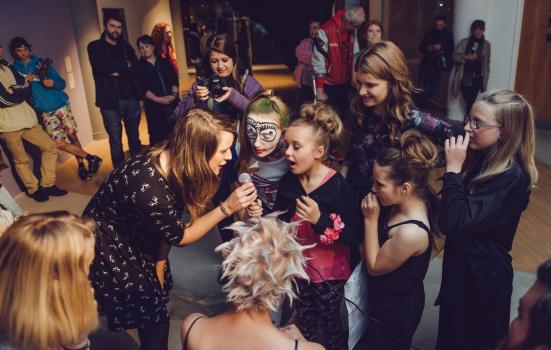Arts organisations have a key role to play helping communities “come together, to learn, debate and celebrate” but they need more support, according to a new report from the Calouste Gulbenkian Foundation.

Green Beanz (c) Effervescent 2016
Arts organisations have a crucial civic role to play, but need more support if they are to fulfil their potential, a wide-reaching inquiry has concluded.
The report – the first to emerge from the Calouste Gulbenkian Foundation’s inquiry into the civic role that arts organisations play nationally and in their communities – finds that arts organisations can play a strong ‘connector’ role in local communities.
Arts organisations are partnering with the social sector, public authorities and commercial organisations to co-produce solutions with communities to the problems they face. But, the report warns, this kind of work remains an aspiration for many organisations.
“Our cohort are ambitious but already overstretched,” it says.
The report identifies five metaphors for the roles arts organisations perform in their local communities. It summarises that arts organisations can act as:
- Colleges – places of learning;
- Town halls – places of debate;
- Parks – public space open to everyone;
- Temples – places which give meaning and provide solace; and
- Home – a place of safety and belonging.
Over-stretched and under-supported
The report concludes that arts organisations require additional training and support to fulfil these roles, and to communicate the value of what they do. It warns that arts leaders with a strong civic role “appear over-stretched and under-supported”.
Other key issues the report identifies include:
- Approaches to funding and evaluation that make sustaining civic work difficult, for example short-term project funding that inhibits the development of long-term engagement
- An arts workforce that does not reflect its communities, and difficulties engaging participants that are representative
- A lack of a common language and classification system for the civic role, which leaves arts organisations needing support to articulate and communicate the value and importance of the work they do
- A need for additional training and support for producers, curators and artists to develop the skills needed to co-produce work with communities.
“Truly inspiring”
The report, ‘Rethinking Relationships’, presents the results of research and a consultation, including a literature review, interviews, a survey of arts practitioners and four local area studies. It also contains a series of case studies from organisations based in the UK and around the world, including Battersea Arts Centre, Belarus Free Theatre and Forklift Danceworks, based in Texas, USA.
Andrew Barnett, Director of the UK Branch of the Calouste Gulbenkian Foundation, said that as funding for public facilities such as libraries and parks has decreased, arts organisations have stepped in and are providing space for communities “to come together, to learn, debate and celebrate what makes them unique”.
“Some of the examples of arts organisations work we have come across during our research have been truly inspiring,” he added.
One case study shared in the report is Plymouth-based Effervescent, which works with vulnerable children and young people to make art for the public. Its projects have included an exhibition produced with sexual abuse survivors, which attracted around 20,000 people during its 13-week run and helped increase the confidence of its participants.
A contested term
The term ‘civic role’ was contested during the consultation and the report addresses this.
“Our intention has never been to redirect arts organisations from their primary purpose of
producing work of artistic excellence,” the report says. “But we do want to help them to maintain their relevance, meet their potential as actors in the public sphere and increase their impact.”
Rather than defining the term ‘civic role’, the researchers present a set of principles that they found civically engaged arts organisations have in common. They are inviting feedback on these.
The report says civically engaged arts organisations are “dedicated to artistic excellence and fostering individual creativity”. They put communities at the heart of their practice and integrate their community work with their artistic programmes.
Themes of ‘everyday creative’ and ‘cultural democracy’ – which were recently championed by a King’s College London report – emerge strongly in the report. Many of the case studies describe approaches based on co-production and helping non-professionals develop creative skills.
One section of the report is dedicated to tracing the long history of arts organisations engaging with their civic role. The researchers see this as having begun with a concern for widening access through the development of education and community work, and continued with work which “engages communities in creating content that reflects social, environmental and economic issues”.
A three-phase inquiry
The research has been undertaken by the Calouste Gulbenkian Foundation in partnership with KCL, the Institute of Cultural Capital, What Next?, and the RSA.
The report marks the end of the first of three phases of the inquiry, which was launched last year, and set out to increase awareness of the civic role that arts organisations play, identify ‘next practice’, and issue recommendations on how policy change and practical support can strengthen this role.
With a focus on publicly funded arts in England, it responds to a number of social, economic and environmental trends, including how technology is changing the way people consume culture; funding cuts; increasing inequality; and the “growing disillusionment with conventional politics”. The political events of the past year have, the report says, made the inquiry “even more salient”.
The second phase of the inquiry, which will run over the summer and autumn, will look in more detail at public policy, funding, capacity building and how the development of civically engaged practice can be supported. The Foundation is currently inviting feedback on these areas.
The final phase of the inquiry will result in a blueprint to grow the arts sector’s civic role across communities. The final report is due to be published in 2019.




